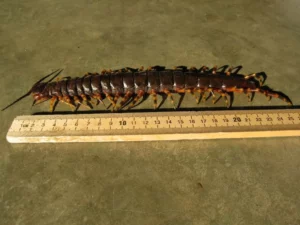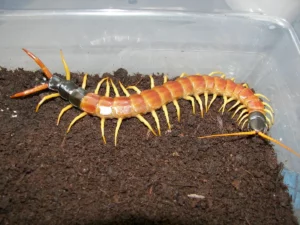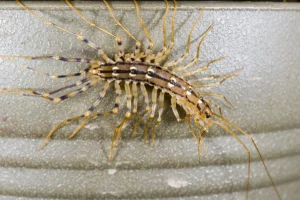Centipedes are classified into four orders- Craterostigmomorpha, Geophilomorpha, Lithobiomorpha and Scolopendromorpha, under the class Chilopda. Some examples are mentioned below-
- Ethmostigmus trigonopodus
- Geophilus flavus
- Geophilus hadesi
- Geophilus rubens
- Lamyctes adisi
- Lithobius forficatus
- Pachymerium ferrugineum
- Scolopendra galapagoensis
- Scolopendra gigantea
- Scolopendra heros
- Scolopendra morsitans
- Scolopendra subspinipes mutilans
- Scolopendra viridicornis
- Scutigera coleoptrata
- Scutigera forceps
- Scutigerella immaculata
Ethmostigmus trigonopodus
Ethmostigmus trigonopodus are blue legged centipedes that are commonly found in Nigeria. They belong from the order Scolopendromorpha can grow up to a length of 14 centimeters. Their optimum temperature is about 23-26°C.

Geophilus flavus
A species under the order Geophilomorpha, Geophilus flavus are yellow in color. An adult Geophilus flavus may grow up to a size of 4.5 centimeters with nearly 49 to 57 pairs of legs. A young one can regenerate legs. These are opportunistic predators and can prey on a huge variety of prey.
Geophilus hadesi
Geophilus hadesi are known to thrive in the deepest caves of the world. They show troglomorphism in order to adapt to the constant dark environment inside the caves. They possess elongated trunks and appendages. Their legs are longer than the width of their body and possess unusually long claws.
Geophilus rubens
Geophilus rubens are another type of soil centipedes which can grow up to be 4.5 centimeters in length. They usually possess 47 to 53 pairs of legs. Another common feature includes black strips on the dorsal side. Their most common prey include drosophila, larvae of flies, earthworms and eggs of snails.
Lamyctes adisi
Lamyctes adisi are Amazonian Geophilomorphs, which are usually found submerged in the water. They have undergone morpho-anatomical respiratory modifications in their spiracles. They have a submerged egg stage in their life cycle too.
Lithobius forficatus
Lithobius forficatus are often found in flood plain and are tolerant to be being submerged in the water. The body size of an adult can grow up to about 0.3 centimeters and possesses around 33 to 43 segments. The last pair of legs which are employed for restraining the prey are slightly longer and thicker than the rest.

Pachymerium ferrugineum
Pachymerium ferrugineum is a species of soil centipedes with body size around 50mm. They are reddish orange in color. The number of segments in their body depends on the area they belong from. The number of pairs of legs differ from 45 to 59 pairs in different areas.
Scolopendra galapagoensis
Scolopendra galapagoensis, also called Galapagos giant centipedes, are somewhat similar to the Amazonian giant centipedes of Scolopendra gigantea. Their body colors vary a lot. Those with green to black colored body possess orangish legs. While those with reddish body possess yellow legs.
Scolopendra gigantea
Scolopendra gigantea is the largest species of tropical centipede in the world. It can grow up to a length of about 30 centimeters or more. Their head color varies from dark brown to reddish brown in color and legs having strips of yellow and brown with yellow claws.

Scolopendra heros
Scolopendra heros are also called the Giant redheaded centipede or giant dessert centipede. Their body colors vary a lot depending upon the area they are found in. They show aposematism. Those with red colored head have black body and yellow legs. While those with black head have brown colored body with yellow legs.

Scolopendra morsitans
Scolopendra morsitans are cosmopolitan centipedes that can grow up to a varied length from around 2 to 6 centimeters. Their body possess nearly 20 segments. Their 21 pairs of legs vary from yellow to red to green in color.
Scolopendra subspinipes mutilans
Scolopendra subspinipes mutilans, also known as Chinese red-headed centipede, are known to have medicinal properties. Proteins present in them have been discovered to lower the levels of cholesterol, triglycerides, and low-density lipoprotein. A novel peptide which inhibits Factor Xa (FXa), has been discovered. This peptide has been found to prolong blood clotting time in mice.
Scolopendra viridicornis
Scolopendra viridicornis, also known Amazonian giant centipede, are commonly found in Brazil. They possess a novel antimicrobial peptide called lacrain. Lacrain, composed of eight amino acid residues, show high antibacterial activity. It can be used to develop drugs against antimicrobial resistant bacterial strains.
Scutigera coleoptrata
Scutigera coleoptrata are common house centipedes, that can grow up to a size of 2.5 to 3 centimeters and have elongated legs. Their posterior legs function as rear antennae. The color of their body varies from olive green to yellow. The ventral surface of their body is covered in strips and the legs have black rings on them.

Scutigera forceps
Scutigera forceps is common house centipede that grow up to 2.5 centimeters. Among the fifteen pairs of legs, the last pair are 5 centimeters long, which vibrate vigorously during feeding. Their antennae are long and slender too. They have greyish yellow body marked with three longitudinal dark strips.
Scutigerella immaculata
Scutigerella immaculata species possesses a translucent body that can grow up to a length of about half a centimeter to 0.8 centimeters. long, and may become very abundant. They are well-known agricultural pests of sugerbeet, maize and potato. They feed on the germinated seeds or small roots of the seedlings of the plants.
Conclusion
Centipedes are carnivorous and poisonous animals that can feed on animals larger than them. They have differently adapted species with vibrantly colored body parts to war off predators.
Also Read:
- Marine algae example
- Plant cell vs animal cell
- Fungi cell membrane and bacteria cell membrane
- Transplanting plants examples
- Are endonucleases restriction enzymes
- Hexapoda examples
- Commensal examples
- Mitosis
- Insectivorous plant example
- Passive transport examples
Hi …I am Tulika Priyadarshini, I have completed my Master’s in Biotechnology. Writing gives me mental peace and satisfaction. Sharing the knowledge that I gain in the process is a cherry on the cake. My articles are related to Lifesciences, Biology and Biotechnology. Lets connect through LinkedIn-